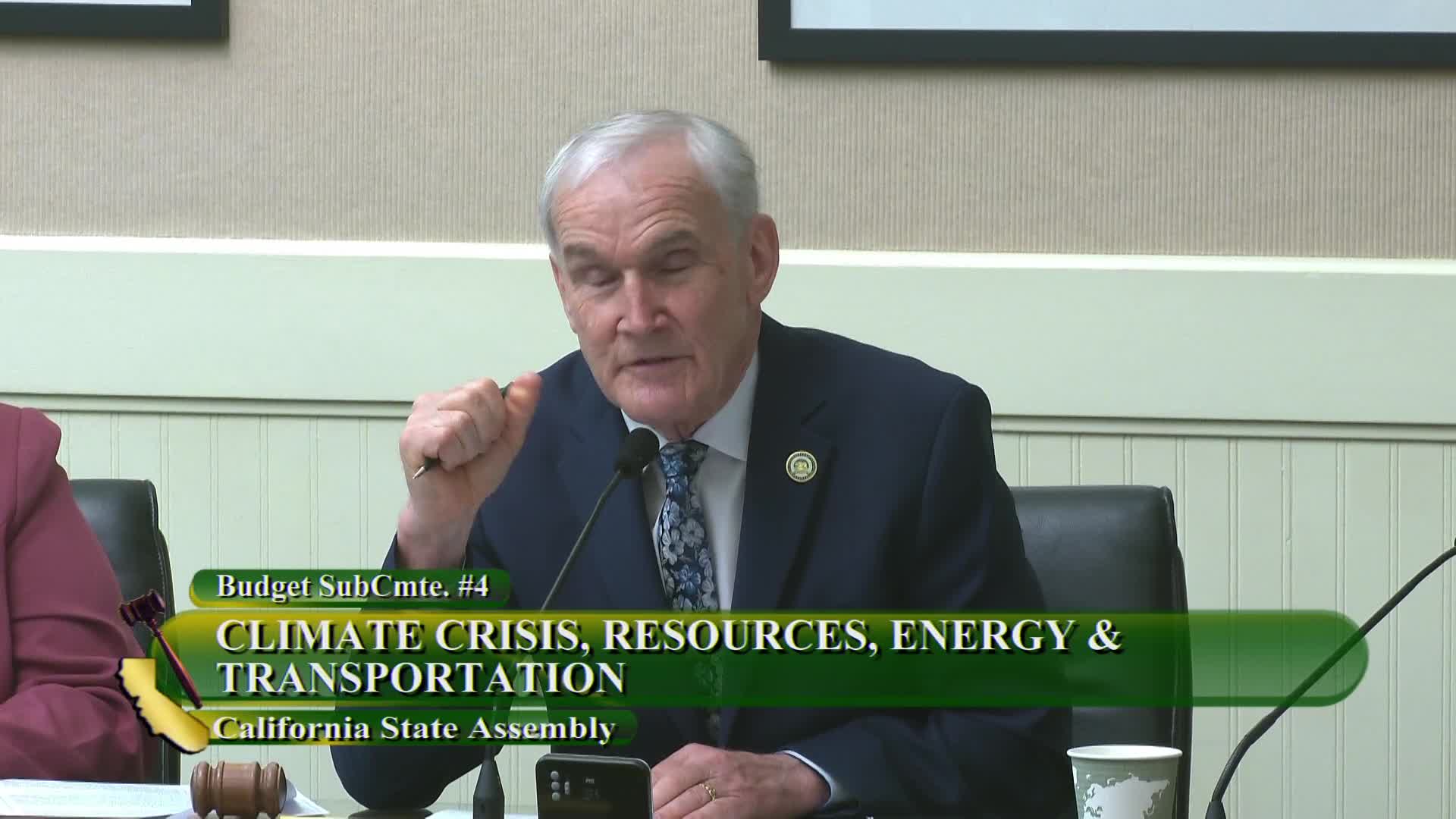California experts advocate for grid-scale battery investment and carbon credit reform
April 30, 2025 | California State Assembly, House, Legislative, California
This article was created by AI summarizing key points discussed. AI makes mistakes, so for full details and context, please refer to the video of the full meeting. Please report any errors so we can fix them. Report an error »

In a recent meeting of the Assembly Budget Subcommittee No. 4 on Climate Crisis, Resources, Energy, and Transportation, California lawmakers gathered to discuss pressing issues surrounding climate change and energy sustainability. The atmosphere was charged with urgency as members explored innovative strategies to enhance community resilience against climate threats while also addressing the economic implications of these initiatives.
One of the key discussions centered on the concept of community home hardening. Assemblymember Erwin emphasized the importance of collective efforts in fortifying homes against natural disasters, suggesting that isolated improvements would not suffice. “To get that twofer,” he noted, referring to the dual benefits of lower home insurance and electricity rates, “you need the whole community to be able to harden.” This sentiment resonated throughout the meeting, highlighting the interconnectedness of individual and community efforts in combating climate risks.
The conversation then shifted to the need for increased investments in technology, particularly in battery technology, which is seen as crucial for California's decarbonization strategy. Experts warned that the introduction of tariffs could significantly raise the costs of batteries, potentially hindering progress. “Any way to subsidize or accelerate manufacturing of grid-scale batteries here in California would make a difference,” one panelist remarked, stressing the urgency of local production to reduce reliance on imports.
Another significant topic was the management of California's cap-and-trade program, which has faced challenges due to an oversupply of carbon credits leading to price volatility. Experts suggested that a reevaluation of market design could stabilize revenue streams and enhance predictability in pricing. “If you want to make that more certain, you may need to consider changes to the market design,” one expert advised, indicating that a more balanced supply and demand could lead to a healthier market.
Assemblymember Kaye proposed a novel approach to funding climate initiatives, suggesting that a portion of the revenue generated from carbon pricing could be allocated directly back to consumers. This would not only support climate programs but also mitigate the financial burden on residents. “We can do things like pay people’s renewal at the DMV,” she suggested, illustrating a creative way to ensure that climate policies do not disproportionately affect low-income households.
As the meeting concluded, the discussions underscored a collective commitment to addressing climate change through innovative solutions and community engagement. The path forward remains complex, but the dialogue among lawmakers and experts reflects a growing recognition of the need for collaborative action in the face of an escalating climate crisis. With the stakes higher than ever, California's approach to these challenges will likely serve as a model for other states grappling with similar issues.
One of the key discussions centered on the concept of community home hardening. Assemblymember Erwin emphasized the importance of collective efforts in fortifying homes against natural disasters, suggesting that isolated improvements would not suffice. “To get that twofer,” he noted, referring to the dual benefits of lower home insurance and electricity rates, “you need the whole community to be able to harden.” This sentiment resonated throughout the meeting, highlighting the interconnectedness of individual and community efforts in combating climate risks.
The conversation then shifted to the need for increased investments in technology, particularly in battery technology, which is seen as crucial for California's decarbonization strategy. Experts warned that the introduction of tariffs could significantly raise the costs of batteries, potentially hindering progress. “Any way to subsidize or accelerate manufacturing of grid-scale batteries here in California would make a difference,” one panelist remarked, stressing the urgency of local production to reduce reliance on imports.
Another significant topic was the management of California's cap-and-trade program, which has faced challenges due to an oversupply of carbon credits leading to price volatility. Experts suggested that a reevaluation of market design could stabilize revenue streams and enhance predictability in pricing. “If you want to make that more certain, you may need to consider changes to the market design,” one expert advised, indicating that a more balanced supply and demand could lead to a healthier market.
Assemblymember Kaye proposed a novel approach to funding climate initiatives, suggesting that a portion of the revenue generated from carbon pricing could be allocated directly back to consumers. This would not only support climate programs but also mitigate the financial burden on residents. “We can do things like pay people’s renewal at the DMV,” she suggested, illustrating a creative way to ensure that climate policies do not disproportionately affect low-income households.
As the meeting concluded, the discussions underscored a collective commitment to addressing climate change through innovative solutions and community engagement. The path forward remains complex, but the dialogue among lawmakers and experts reflects a growing recognition of the need for collaborative action in the face of an escalating climate crisis. With the stakes higher than ever, California's approach to these challenges will likely serve as a model for other states grappling with similar issues.
View full meeting
This article is based on a recent meeting—watch the full video and explore the complete transcript for deeper insights into the discussion.
View full meeting
